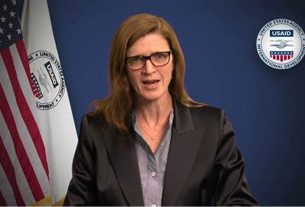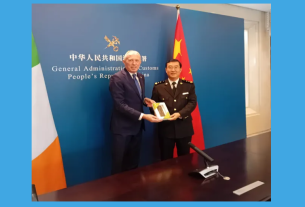|
Getting your Trinity Audio player ready...
|
Leontien Kremer shifted the entire focus of her work as a young doctor in 1997 after an encounter she had with a cured cancer patient.
‘We had treated a boy of 16 for bone cancer, but then he came back a fewer years later with severe heart failure,’ said Kremer, a paediatrician at a Dutch children’s hospital called the Princess Máxima Centre in Utrecht.
Late effects
The case motivated her to study cancer survivors in the Netherlands. She discovered that one in 20 patients treated with a type of anticancer drug developed heart failure as many as 30 years after treatment.
‘This was much higher than we had suspected,’ said Kremer, who now runs a research group that specialises in improving the care of childhood cancer survivors and is also a professor in paediatrics at the University of Amsterdam.
While a cancer diagnosis is less grim that it once was – a tumour is now more often removed or frozen in time with therapies – and more people survive the disease, the longer-term effects of treatments for it are gaining medical scrutiny.
None of this is to downplay the impact of cancer itself.
In the EU in 2020, 2.7 million people were diagnosed with cancer and 1.3 million people – including more than 2 000 children – died from it. The European Commission in 2021 pledged a range of actions in Europe’s Beating Cancer Plan reflecting a high-level political commitment to tackle the disease.
These include research actions under a “Cancer Mission” focused on new technologies and on the most advanced knowledge of the disease – from its start and progression to diagnosis and prevention – to improve patients’ health.
Recognition is growing that many people who become cured of cancer can be vulnerable to a range of other illnesses later in life.
Special checks
“
We can say one out of three cancer patients will have severe late effects from their treatment.
As a result, these people should have special check-ups years afterwards because such examinations will save lives, according to Kremer.
Delayed harm to health stems from chemo and radiation therapy. While these powerful treatments kill cancer cells, they also injure healthy ones.
“Alkylating agents”, for instance, stop cancer cells from multiplying by injuring their DNA, but they can cause infertility several years later.
‘We can say one out of three will have severe late effects from cancer treatment,’ Kremer said.
Because the number of cancer survivors will grow in the years and decades ahead, more cases of late health damage are expected.
Step ahead
While some European countries including the Netherlands have drawn up plans of action for ex-cancer patients, Kremer wants to go a step further.
She helped set up a Europe-wide collaboration of doctors called PanCare to take a closer look at late effects.
A project called PanCareFollowUp received EU funding to compile a “how to” guide on monitoring such delayed effects for paediatric cancer units across Europe. The project, coordinated by the Princess Máxima Centre, is due to wrap up in December 2023 after five years.
‘We should do this together in Europe, which will avoid a huge duplication of effort,’ said Kremer.
She offered a concrete example in the area of cardiovascular health: with chemotherapies based on a chemical compound known as anthocyanin, the dose given influences the later risk of heart damage and whether a person should get a test every two or every five years.
If a problem is spotted, a person can receive drugs to lower the risk of severe heart disease.
Big benefits
The potential benefits of this approach are far-reaching given the numbers involved.
“
It is important to be alive, symptom-free, but it’s also important to have a good quality of life.
In Italy, with a population of almost 60 million, around 4 million people have or have had a cancer diagnosis, according to Dr Apolone Giovanni, scientific director of the National Cancer Institute in Milan.
‘In the last 10 years we have made a lot of progress in detecting cancer earlier and then treating patients,’ he said. ‘When we are not able to cure the cancer, often we can freeze it.’
Giovanni knows about cancer from both sides of the doctor’s desk. He was diagnosed with early kidney cancer 12 years ago.
The tumour was surgically removed. Five years ago, he had a relapse and now takes medication to keep the cancer in check.
Giovanni leads an EU-funded research project called EUonQoL to improve the quality of life of cancer patients and survivors in Europe.
Part of the Cancer Mission, the four-year initiative runs until the end of 2026 and plans to gauge patients’ views through a survey.
The survey is due to be tested from June 2024 to October 2024 on a group of 4 000 people.
‘We will then use the final version to collect real data and have the first snapshot of the quality of life for cancer patients across Europe,’ said Giovanni. ‘This will increase our capabilities to monitor quality of life at a population level.’
Personal perspectives
His own cancer has given him a new perspective.
‘It is important to be alive, symptom-free, but it’s also important to have a good quality of life, which is more than just an absence of symptoms,’ said Giovanni. ‘Our tool will allow policymakers to collect information about the perception of quality of life in cancer patients and compare between countries and even regions within countries.’
Such information can help align standards across Europe, where the quality of care that cancer patients and survivors receive varies.
Victor Girbu, a cancer survivor from Moldova, sees plenty of room for improvement on this front.
Victor Girbu
‘There is long-term follow-up care only in some countries,’ said Girbu, who was diagnosed with kidney cancer after birth and underwent his first surgery at the age of six months, when his right kidney was removed.
He continued to receive treatment in Moldova’s capital Chișinău until the age of 17, when an orange-sized tumour was removed from his left kidney.
‘After that I struggled mentally and physically,’ said Girbu.
A law graduate, he got involved in an advocacy network called Youth Cancer Europe while living in Romania and said efforts such as Europe’s Beating Cancer Plan can trigger improvements at the national level.
Girbu is also engaged in a dialogue that the Cancer Mission has established with young survivors of the disease. The purpose is to gain a better understanding of their needs and to address them through jointly developed actions.
Back in the Netherlands, Kremer is pushing for doctors and hospitals treating childhood cancer in Europe to broaden their approach.
‘The focus is on surviving and reducing mortality, but we are convinced that the focus should also be on late effects,’ she said.
Research in this article was funded by the EU. If you liked this article, please consider sharing it on social media.
Beating cancer
Europe accounts for a quarter of the world’s cancer cases while representing 10% of the global population. In the EU in 2020, 2.7 million people were diagnosed with cancer and another 1.3 million people died from the disease.
The EU Mission on Cancer aims to improve the lives of more than 3 million people by 2030 through a range of actions including treatment. As a major component of the EU’s investment in cancer research and innovation, the Mission will deepen understanding of the disease, focus on prevention and earlier diagnosis and improve patients’ quality of life during and after their treatment.
Together with the Mission, Europe’s Beating Cancer Plan is tackling the entire disease pathway from prevention to quality of life. It will enable expertise and resources to be shared across the EU, helping researchers exchange findings and medical staff and hospitals to tap into common sources of data.



